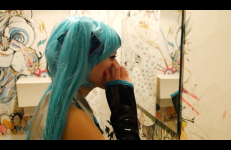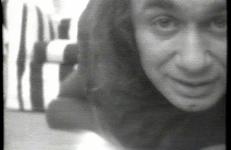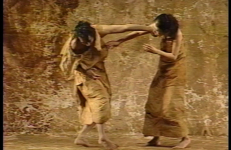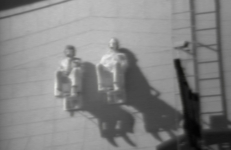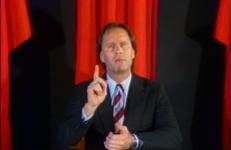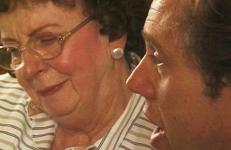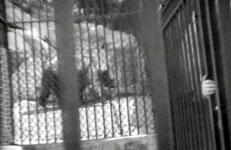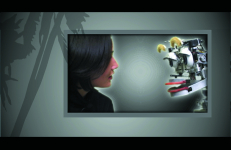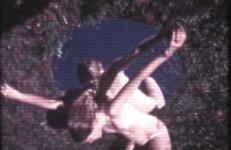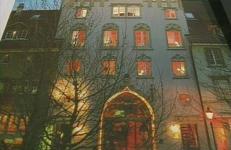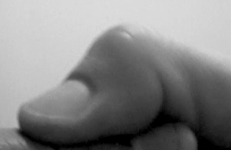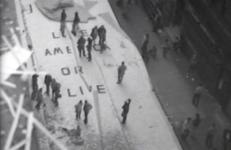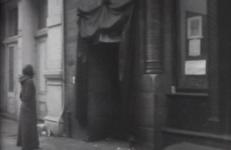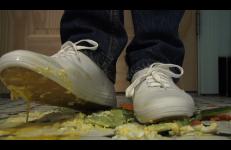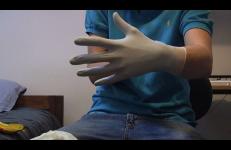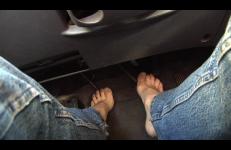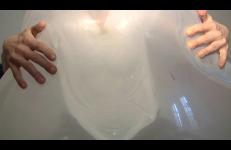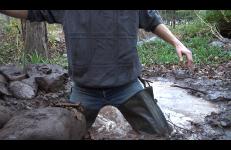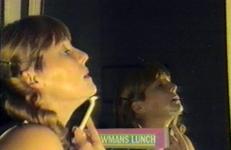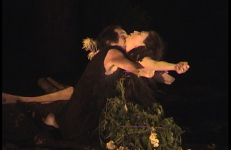Hatsune Miku is a co-creation platform, personified by a cute and oddly seductive animated character. Fans bring her to life by creating content that she “delivers”. Her entire persona: lyrics, music and animation – is fan created, and that's her charm. Cosplaying Hatsune Miku, Ann Oren goes to Tokyo for a performative journey among these fans and explores the Miku phenomenon as an expression of collective fantasy. The habits of Miku's fans is a familiar exaggeration of our social media habits, that flood us with crowd creativity.
Performance
In a vile and ingenious way, Acconci pleads with the camera/spectator to join with him, to come to him, promising to be honest and begging, "I need it, you need it, c'mon... look how easy it is." Acconci addresses the viewer as a sexual partner, acting as if no distance existed between them. The monitor becomes an agent of intimate address, presenting a disingenuous intimacy that is one-sided and pure fantasy, much like the popular love songs in the background with which Acconci croons, "I'll be your baby, I'll be your baby tonight, yeah, yeah."
Their first longer piece entirely in silence. The backdrop and floor were painted with a burned flour paste which crumbled down as they moved. In bright light, Eiko & Koma became thirstier as the four sections progressed, seeking both water and intimacy in an extreme setting.
April 26, 1976. San Francisco. Doug Hall and Jody Procter of T.R. Uthco, a San Francisco art/performance group, sat 60 feet above the pavement in chairs bolted to the masonry wall outside the east windows of the third floor of La Mamelle Gallery on 12th Street. They sat from 9:00 in the morning until 3:00 in the afternoon, and during this time They talked continuously. The two performers were clearly visible to spectators on the street below. The sounds of their amplified voices and video images from two nearby cameras were fed into the gallery space.
April 26, 1976. San Francisco. Doug Hall and Jody Procter of T.R. Uthco, a San Francisco art/performance group, sat 60 feet above the pavement in chairs bolted to the masonry wall outside the east windows of the third floor of La Mamelle Gallery on 12th Street. They sat from 9:00 in the morning until 3:00 in the afternoon, and during this time They talked continuously. The two performers were clearly visible to spectators on the street below. The sounds of their amplified voices and video images from two nearby cameras were fed into the gallery space.
“Similar in structure to The Speech, this tape suggests the gesture and language of the television proselytizer as opposed to the politician.”
— Doug Hall
“This Is The Truth is a recitation of the rules and social codes that makes evident the results of strategic posturing and facial expression on television. Through emblems and selected phrases, Hall dissects those components that produce the image of authority.”
— Bob Riley, The CAT Fund Presents: Doug Hall (Boston: Institute of Contemporary Art, 1986-87)
Threads of Belonging depicts the daily life of Layton House, a fictional therapeutic community, where doctors live with their schizophrenic patients. The characters and events of Layton House were drawn from writings of the anti-psychiatry movement, whose most famous proponent was R.D. Laing. In this film we see experimental therapies, power struggles, and the individual arcs of mental illness converge, as a community struggles to understand itself and determine its destiny.
Forti uses the camera as a research tool to record the movements of three grizzly bears pacing anxiously behind the bars of their cage in the Brooklyn Zoo. The collected visual information becomes part of the basis for Forti's movements in Solo No. 1.
Three Tales was commissioned in the late 1990s by different international music festivals to reflect on 20th century life as the new century approached. It recalls three well known events from the early, middle, and late 20th century—Hindenburg, Bikini, Dolly. Each of these events reflects on the growth and implications of technology during the 20th century from early air transport to the current ethical debate on the future of our species.
Three Tales was commissioned in the late 1990s by different international music festivals to reflect on 20th century life as the new century approached. It recalls three well known events from the early, middle, and late 20th century—Hindenburg, Bikini, Dolly. Each of these events reflects on the growth and implications of technology during the 20th century from early air transport to the current ethical debate on the future of our species.
Performers throw themselves into an underground passageway. They exit through the mirror, a symmetrical mirror world which exists because of the placement and angle of the mirror as an upside-down place.
Performers: Ellen Krueger and Monica Wilson
As the camera looks out through a barred window and the clock strikes four in a Swiss city, the death of Yasser Arafat provides the starting point for a journey back in time.
Throwing Stones is the third episode in the Hotel Diaries series, a collection of video recordings made in the world’s hotel rooms, which relate personal experiences and reflections to contemporary conflicts in the Middle East.
A dance, performed by A.K. Burns and Lanka Tattersall
This title is also available on A.K. Burns: Early Videoworks
Danny Tisdale is a performance artist from New York City. His performances challenge prevailing ideas of race, assimilation, appropriation and success by offering passers-by the chance to racially change their appearance as a means to achieve greater financial success. The mimicry of museological practices of cataloguing and preservation, display and presentation provides one of a range of rhetorical frameworks upon which Danny Tisdale hangs his practice of social critique.
The Videofreex document a street intervention by Turkish artist Tosun Bayrak (b.1926). The performance was to become a notorious example of the element of "shock" in contemporary art. Within the work:
In this tape the Videofreex document an impromptu experimental art gathering in 1971, hosted by New York artist, Tosun Bayrak. Before entering the gathering, the Freex record their encounters with a police officer, passersby, and a member of Vegetarians for Ecological Action (an animals’ rights activist group) protesting the misuse of animals in performance art.
The first video of the installation Touch Parade, which as a whole explores “plastic love” or fetish culture and the assimilation of marginalized sexuality on the internet. In questioning what is an explicit and/or illicit image, fetishes found on YouTube that consist of banal gestures, are re-performed. Unlike other pornographic content, these videos evade censoring because they are not culturally recognized as representations of sexuality.
The fourth video of the installation Touch Parade, which as a whole explores “plastic love” or fetish culture and the assimilation of marginalized sexuality on the internet. In questioning what is an explicit and/or illicit image, fetishes found on YouTube that consist of banal gestures, are re-performed. Unlike other pornographic content, these videos evade censoring because they are not culturally recognized as representations of sexuality.
The fifth video of the installation Touch Parade, which as a whole explores “plastic love” or fetish culture and the assimilation of marginalized sexuality on the internet. In questioning what is an explicit and/or illicit image, fetishes found on YouTube that consist of banal gestures, are re-performed. Unlike other pornographic content, these videos evade censoring because they are not culturally recognized as representations of sexuality.
The second video of the installation Touch Parade, which as a whole explores “plastic love” or fetish culture and the assimilation of marginalized sexuality on the internet. In questioning what is an explicit and/or illicit image, fetishes found on YouTube that consist of banal gestures, are re-performed. Unlike other pornographic content, these videos evade censoring because they are not culturally recognized as representations of sexuality.
The third video of the installation Touch Parade, which as a whole explores “plastic love” or fetish culture and the assimilation of marginalized sexuality on the internet. In questioning what is an explicit and/or illicit image, fetishes found on YouTube that consist of banal gestures, are re-performed. Unlike other pornographic content, these videos evade censoring because they are not culturally recognized as representations of sexuality.
75 people speak 50 languages sometimes simultaneously.
This title is also available on Sympathetic Vibrations: The Videoworks of Paul Kos.
Zachte Berm (from Weiner’s film Plowman’s Lunch) sits with her back to the camera in front of a large mirror—her face, covered with shaving cream, is seen in its reflection. As the soundtrack begins, she tries to lip-sync to the spoken words, “Art is not a metaphor upon the relationship of human beings to objects and objects to objects in relation to human beings but a representation of an empirical existing fact,” while shaving.
In this interview, Los Angeles-based artist and filmmaker Ryan Trecartin (b. 1981) discusses his personal interests and motivations, as well as the larger cultural and philosophical concerns that shape his videos and their reception. Trecartin is known for his construction of non-linear narratives, campy costumes, and excessively visceral characters and environments. One of the most compelling aspects of this interview is his insistence that language and its verbal articulation, rather than the visual, anchor his process. Trecartin identifies the influences of 1990s retro-rave culture, hip-hop videos, and editing software tools on his work. He notes that the accelerated disintegration of high and low culture has played a major part in his growth as an artist.
In Tree Song, Eiko & Koma continue their exploration of the body as a part of the landscape and the landscape as an extension of the body. Trees have been symbols of resilience, rebirth and portals through which spirits pass. Tree Song honors the iconography of trees and the primal mysteries of landscape and the human body.




